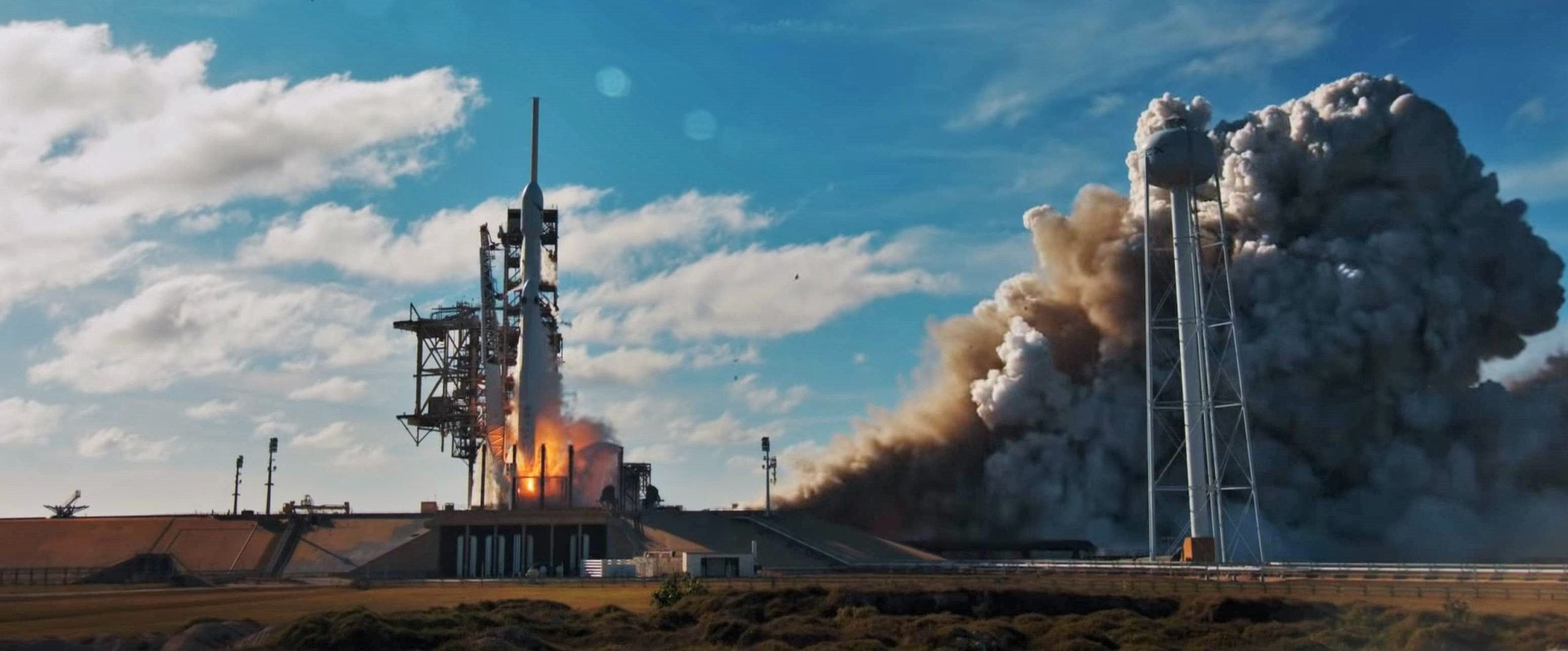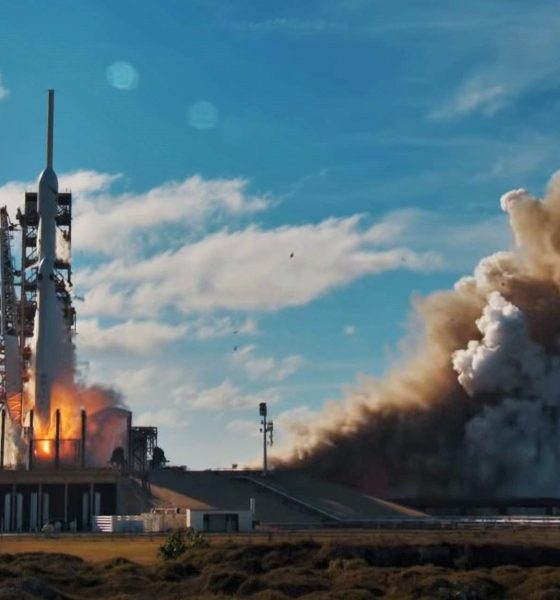

SpaceX
SpaceX fires up Falcon Heavy Block 5 for the first time, launch date announced
SpaceX has successfully ignited a Block 5 variant of its Falcon Heavy rocket for the first time ever, also marking the second-ever integrated static fire of the heavy-lift launch vehicle. According to SpaceX, the company will aim for an extraordinary four-day turnaround from static fire to launch, targeting liftoff as early as 6:36 pm EDT (22:36), April 9th.
Captured in a spectacular 4K video from a few miles away, it appears that the giant rocket managed to ignite all 27 Merlin 1D engines for no more than 3-4 seconds, an average length for Falcon 9 but quite a bit shorter than the 7-10 seconds Falcon Heavy fired for during its Flight 1 preparations.
During the Block 5 rocket’s first-ever integrated ignition test, all 27 Merlin 1D engines were (nominally) ignited in sequence, albeit just a handful of milliseconds apart from each other. During Falcon Heavy’s inaugural static fire and launch, CEO Elon Musk indicated that performance was capped at ~92% – 4.7 million pounds (~2115 metric tons) of thrust – for unspecified reasons. Assuming SpaceX has decided to uncap Falcon Heavy’s performance this time around, the rocket could have produced upwards of 5.6 million pounds (2550 metric tons) of thrust and will – again, according to Musk – have “way more performance than last year’s vehicle.” On top of the 8% increase from uncapping the rocket’s performance, Falcon 9 Block 5 introduced an additional 10% thrust increase for Merlin 1D engines, ultimately raising Falcon Heavy’s max thrust by a spectacular 20% in just one year.
With three times as many boosters as a single core Falcon 9 rocket, a Falcon Heavy static fire fundamentally produces as much as 100% more (2X as much) data as Falcon 9 during, requiring a fair bit more time to have engineers comb through it to verify vehicle health. The ultimate goal is for the vast majority of this work to be done by the rocket itself, which is actually what ends up shining through during what is known as the ‘quick-look review’ that shortly follows static fires, but Falcon Heavy is likely too new of a rocket for that just yet.
To temper expectations for this highly-anticipated launch, SpaceX took more than eight days to take Falcon Heavy Flight 1 from a planned static fire attempt to actual ignition, with an additional 13 days separating the successful static fire and the first official launch window. The consequences of sidestepping caution with Falcon Heavy could reach as high as the near-complete destruction of SpaceX’s Launch Complex 39A pad facilities, an absolutely mission-critical foundation for the first attempted crew launch of Crew Dragon and future astronaut launches to the International Space Station (ISS). As such, any unnecessary risk itself risks raising the ire of NASA and the US government in general, as it would also fundamentally be a conscious decision to risk the stability of US access to the Space Station for the sake of shaving a few days or weeks off of a commercial launch schedule.
SpaceX typically provides an update via Twitter 15-60 minutes after a Falcon preflight static fire test to announce whether the data generally looks good or if additional time is needed to analyze the rocket’s performance. According to a since-deleted USAF 45th Space Wing tweet, a healthy-looking static fire from Falcon Heavy Flight 2 would pave the way for a launch attempt no earlier than 6:36 pm EDT (22:36 UTC), April 9th.
This article will be updated with any additional information about Falcon Heavy’s health and launch date targets as soon as it becomes available.
Check out Teslarati’s Marketplace! We offer Tesla accessories, including for the Tesla Cybertruck and Tesla Model 3.

Elon Musk
Starlink passes 9 million active customers just weeks after hitting 8 million
The milestone highlights the accelerating growth of Starlink, which has now been adding over 20,000 new users per day.

SpaceX’s Starlink satellite internet service has continued its rapid global expansion, surpassing 9 million active customers just weeks after crossing the 8 million mark.
The milestone highlights the accelerating growth of Starlink, which has now been adding over 20,000 new users per day.
9 million customers
In a post on X, SpaceX stated that Starlink now serves over 9 million active users across 155 countries, territories, and markets. The company reached 8 million customers in early November, meaning it added roughly 1 million subscribers in under seven weeks, or about 21,275 new users on average per day.
“Starlink is connecting more than 9M active customers with high-speed internet across 155 countries, territories, and many other markets,” Starlink wrote in a post on its official X account. SpaceX President Gwynne Shotwell also celebrated the milestone on X. “A huge thank you to all of our customers and congrats to the Starlink team for such an incredible product,” she wrote.
That growth rate reflects both rising demand for broadband in underserved regions and Starlink’s expanding satellite constellation, which now includes more than 9,000 low-Earth-orbit satellites designed to deliver high-speed, low-latency internet worldwide.
Starlink’s momentum
Starlink’s momentum has been building up. SpaceX reported 4.6 million Starlink customers in December 2024, followed by 7 million by August 2025, and 8 million customers in November. Independent data also suggests Starlink usage is rising sharply, with Cloudflare reporting that global web traffic from Starlink users more than doubled in 2025, as noted in an Insider report.
Starlink’s momentum is increasingly tied to SpaceX’s broader financial outlook. Elon Musk has said the satellite network is “by far” the company’s largest revenue driver, and reports suggest SpaceX may be positioning itself for an initial public offering as soon as next year, with valuations estimated as high as $1.5 trillion. Musk has also suggested in the past that Starlink could have its own IPO in the future.
News
SpaceX shades airline for seeking contract with Amazon’s Starlink rival

SpaceX employees, including its CEO Elon Musk, shaded American Airlines on social media this past weekend due to the company’s reported talks with Amazon’s Starlink rival, Leo.
Starlink has been adopted by several airlines, including United Airlines, Qatar Airways, Hawaiian Airlines, WestJet, Air France, airBaltic, and others. It has gained notoriety as an extremely solid, dependable, and reliable option for airline travel, as traditional options frequently cause users to lose connection to the internet.
Many airlines have made the switch, while others continue to mull the options available to them. American Airlines is one of them.
A report from Bloomberg indicates the airline is thinking of going with a Starlink rival owned by Amazon, called Leo. It was previously referred to as Project Kuiper.
American CEO Robert Isom said (via Bloomberg):
“While there’s Starlink, there are other low-Earth-orbit satellite opportunities that we can look at. We’re making sure that American is going to have what our customers need.”
Isom also said American has been in touch with Amazon about installing Leo on its aircraft, but he would not reveal the status of any discussions with the company.
The report caught the attention of Michael Nicolls, the Vice President of Starlink Engineering at SpaceX, who said:
“Only fly on airlines with good connectivity… and only one source of good connectivity at the moment…”
CEO Elon Musk replied to Nicolls by stating that American Airlines risks losing “a lot of customers if their connectivity solution fails.”
American Airlines will lose a lot of customers if their connectivity solution fails
— Elon Musk (@elonmusk) December 14, 2025
There are over 8,000 Starlink satellites in orbit currently, offering internet coverage in over 150 countries and territories globally. SpaceX expands its array of satellites nearly every week with launches from California and Florida, aiming to offer internet access to everyone across the globe.
Currently, the company is focusing on expanding into new markets, such as Africa and Asia.
News
Tesla hints at Starlink integration with recent patent
“By employing polymer blends, some examples enable RF transmission from all the modules to satellites and other communication devices both inside and outside the vehicle.”

Tesla hinted at a potential Starlink internet terminal integration within its vehicles in a recent patent, which describes a vehicle roof assembly with integrated radio frequency (RF) transparency.
The patent, which is Pub. No U.S. 2025/0368267 describes a new vehicle roof that is made of RF-transparent polymer materials, allowing and “facilitating clear communication with external devices and satellites.”
Tesla believes that a new vehicle roof design, comprised of different materials than the standard metallic or glass elements used in cars today, would allow the company to integrate modern vehicular technologies, “particularly those requiring radio frequency transmission and reception.
Tesla has recently filed a US patent application on integrating RF transparent materials into the roof structure.
“facilitating clear communication with external devices and satellites”
Tesla fleet is getting @Starlink connectivity integration soon. LFG @Tesla @elonmusk… pic.twitter.com/bLa8YtPLd1
— Chansoo Byeon (@Chansoo) December 9, 2025
Instead of glass or metallic materials, Tesla says vehicles may benefit from high-strength polymer blends, such as Polycarbonate, Acrylonitrile Butadiene Styrene, or Acrylonitrile Styrene Acrylate.
These materials still provide ideal strength metrics for crashworthiness, stiffness for noise, vibration, and harshness control, and are compliant with head impact regulations.
They would also enable better performance with modern technologies, like internet terminals, which need an uninterrupted signal to satellites for maximum reception. Tesla writes in the patent:
“By employing polymer blends, some examples enable RF transmission from all the modules to satellites and other communication devices both inside and outside the vehicle.”

One of the challenges Tesla seems to be aware of with this type of roof design is the fact that it will still have to enable safety and keep that at the forefront of the design. As you can see in the illustration above, Tesla plans to use four layers to increase safety and rigidity, while also combating noise and vibration.
It notes in the patent that disclosed examples still meet the safety requirements outlined in the Federal Motor Vehicle Safety Standards (FMVSS).
Starlink integrated directly into Tesla vehicles would be a considerable advantage for owners. It would come with a handful of distinct advantages.
Initially, the inclusion of Starlink would completely eliminate cellular dead zones, something that is an issue, especially in rural areas. Starlink would provide connectivity in these remote regions and would ensure uninterrupted service during road trips and off-grid adventures.
It could also be a critical addition for Robotaxi, as it is crucial to have solid and reliable connectivity for remote monitoring and fleet management.
Starlink’s growing constellation, thanks to SpaceX’s routine and frequent launch schedule, will provide secure, stable, and reliable internet connectivity for Tesla vehicles.
Although many owners have already mounted Starlink Mini dishes under their glass roofs for a similar experience, it may be integrated directly into Teslas in the coming years, either as an upgrade or a standard feature.








